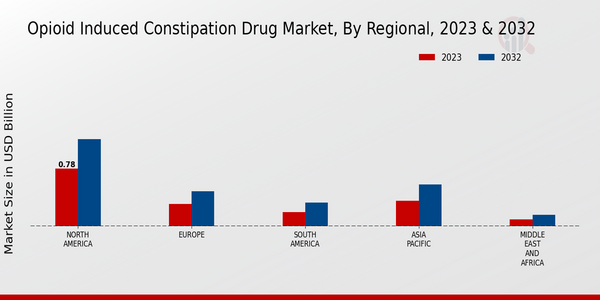Market Growth Projections
Rising Prevalence of Opioid Use
The increasing prevalence of opioid prescriptions globally drives the Global Opioid Induced Constipation Drug Market Industry. As healthcare providers prescribe opioids for pain management, the incidence of opioid-induced constipation (OIC) rises. Reports indicate that approximately 40 percent of patients on chronic opioid therapy experience OIC, leading to a growing demand for effective treatments. This trend is expected to contribute to the market's expansion, with projections suggesting a market value of 1.9 USD Billion in 2024. The rising awareness among healthcare professionals regarding OIC management further fuels the demand for specialized drugs, thereby enhancing market growth.
Advancements in Drug Formulations
Innovations in drug formulations significantly impact the Global Opioid Induced Constipation Drug Market Industry. Pharmaceutical companies are increasingly focusing on developing new agents that target OIC more effectively, with fewer side effects. For instance, the introduction of peripherally acting mu-opioid receptor antagonists (PAMORAs) has transformed treatment options. These advancements not only improve patient outcomes but also expand the market by attracting more patients seeking relief from OIC. As the industry evolves, the market is projected to reach 3.3 USD Billion by 2035, reflecting the positive influence of these innovations on overall growth.
Increasing Awareness and Education
Growing awareness and education about opioid-induced constipation among healthcare providers and patients contribute to the Global Opioid Induced Constipation Drug Market Industry. Initiatives aimed at educating prescribers about the risks of OIC and the importance of preventive measures are gaining traction. This heightened awareness encourages patients to seek treatment options proactively, thereby increasing the demand for OIC drugs. Furthermore, organizations are promoting guidelines for managing OIC, which enhances the visibility of available therapies. As a result, the market is expected to experience a compound annual growth rate (CAGR) of 5.15 percent from 2025 to 2035, indicating a robust growth trajectory.
Regulatory Support for New Treatments
Regulatory support for the approval of new treatments for opioid-induced constipation plays a crucial role in shaping the Global Opioid Induced Constipation Drug Market Industry. Regulatory agencies are increasingly recognizing the need for effective management options for OIC, leading to expedited approval processes for innovative therapies. This supportive environment encourages pharmaceutical companies to invest in research and development, resulting in a wider array of treatment options for patients. As new drugs enter the market, competition intensifies, which may lead to improved pricing and accessibility for patients. This trend is likely to bolster market growth in the coming years.
Demographic Shifts and Aging Population
Demographic shifts, particularly the aging population, significantly influence the Global Opioid Induced Constipation Drug Market Industry. As the global population ages, the prevalence of chronic pain conditions increases, leading to higher opioid prescriptions. Older adults are particularly susceptible to OIC, necessitating effective management strategies. The growing number of elderly patients seeking pain relief is expected to drive the demand for OIC treatments. This demographic trend aligns with the projected market growth, as the industry adapts to meet the needs of an aging population, further solidifying its position in the healthcare landscape.



















